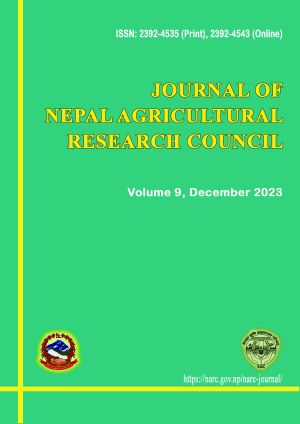Influence of Incubation Condition on the Antibiotic Susceptibility of Salmonella
DOI:
https://doi.org/10.3126/jnarc.v9i1.61601Keywords:
Incubation Condition, Antibiotic Agent, Resistance, SalmonellaAbstract
Bacteria experience changes in physiology and growth patterns in aerobic laboratory culture and the anaerobic gastrointestinal tract of the host. Our study hypothesizes that this physiological difference influences the antibiotic susceptibility/resistance pattern of Salmonella in aerobic and anaerobic conditions. The susceptibility and resistance percentage was determined using the diameter of the zone of inhibition for ten major classes of antibiotic drugs with a total of sixteen molecules. Data were analyzed in GraphPad Prism vs 8 using a two-way ANOVA analysis for the six antibiotics selected based on the greatest differences in the zone of inhibition. The highest observed resistance levels were against nalidixic acid (63.8%/48.6%) and tetracycline (65.2%/58.6%), followed by trimethoprim/ sulphamethoxazole (52.2%/50%), cephalexin (50.7%/52.9%), ciprofloxacin (45.7%/45.7%), amoxicillin (43.5%/47.1%), ampicillin (37.7%/45.7%) and chloramphenicol (36.2%/37.1%) in aerobic/anaerobic condition. The variation contributed by the type of antibiotic on the degree of resistance was 72.73% (P=0.0303) and the variation contributed by the incubation condition was 16.09% (P=0.0437), both of which are statistically significant. The findings of our study demonstrate that the susceptibility/resistance of non-typhoidal Salmonella varies in aerobic and anaerobic incubation. Hence, pharmacodynamics models aiming to evaluate the impact of antimicrobial use in enteric bacteria such as Salmonella of the treated host should utilize measurements of bacterial susceptibility that are obtained anaerobically (as well as aerobically) to achieve effective antimicrobial treatment and control non-typhoidal salmonella infections.
Downloads
Downloads
Published
How to Cite
Issue
Section
License
Copyright (c) 2023 Nepal Agricultural Research Council

This work is licensed under a Creative Commons Attribution-NonCommercial 4.0 International License.




